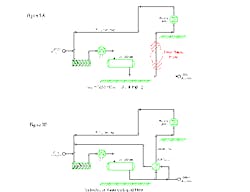Two-phase flow can present challenges. The greatest problems occur when two-phase flow shows up unexpectedly. Elevation changes with equilibrium liquids can lead to such situations. We'll look at a case where uphill piping caused major difficulties.
[pullquote]Proper pressure balance can make a liquid flow uphill in a pipe. However, starting with an equilibrium liquid can cause flashing when elevation changes. The increased volume boosts pressure drop. The resulting flow may either be much lower than expected or cause severe mechanical problems from surging. Proper consideration of intermediate conditions in fluid flow can avoid these problems.
At the site in question, a drum supplies refrigerant to multiple exchangers. The plant added a new service to the existing system (Figure 1a). After commissioning, the new service received only 75% of the required duty.
The design of the new service, like that of many refrigerant exchangers, called for a fully flooded condition on the refrigerant side. Field investigation showed that the level control valve on the refrigerant supply always is fully open. The exchanger doesn't have independent level taps. A neutron backscatter device monitors refrigerant level and indicated that roughly one-third of the tube bundle is above the refrigerant level.
Field investigation continued with a series of pressure readings along the flow loop to the new exchanger. Based on flow rates, the pressure drop in the refrigerant return loop was as expected. However, the pressure drop in the refrigerant supply loop was much higher than expected. The immediate thought was that heat gain through the piping was causing vaporization in the refrigerant line. Inspection showed the new line was well insulated and not likely to have significant heat gain.
While checking the line for insulation condition, the engineer noticed that the new service was at a markedly higher elevation than most of the existing refrigerant exchangers. Review of the design of the new piping showed that elevation changes weren't considered in system hydraulics. The supply drum provided enough head to overcome friction losses but not substantial elevation changes. The height change caused significant vaporization. Even a small percent of vaporization dramatically increased pressure drop.
To get refrigerant to the new exchanger required either changing a sizable amount of piping or keeping the liquid at a pressure above its bubble point. The latter called for either pumping the refrigerant to a higher pressure or cooling it to a lower temperature.
Adding rotating, reciprocating or other machinery with moving parts, even small units, costs a surprisingly large amount after final installation has been completed. So, instead, the plant installed a small subcooler. A slipstream of refrigerant provides cooling for the stream going to the new exchanger. The net result is that refrigerant going there enters the supply line at 30 psi over the saturation pressure. The subcooling eliminates the pressure drop problem. Desired capacity was immediately achieved.
Other situations when two-phase flow can unexpectedly occur include: heat gain into cold systems; flashing across orifice plates or other head meters; mixing dissimilar streams; retrograde condensation through the two-phase region; continuing reactions in lines; internal flows in physically large equipment; and leaks. To a large extent, process analysis can identify all these potential problems, except leaks, before they are created. Remember to check intermediate flow conditions — these may be important — as well as piping inlet and outlet conditions. If you don't check for them, you risk unpleasant surprises. Proper analysis beforehand can head off such problems.
Leaks tend to be more of a troubleshooting issue. Don't forget to think about the impact of low-pressure fluid leaking into high-pressure systems. Consider, e.g., leaks into a vacuum system, process/process leaks, or process/utility leaks. Even small amounts of extra volume can create major pressure drop problems.
Andrew Sloley is a Chemical Processing Contributing Editor. You can e-mail him at [email protected].



